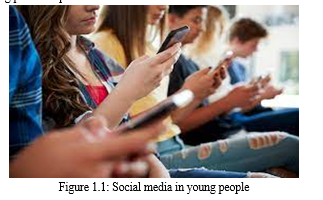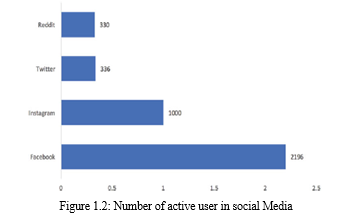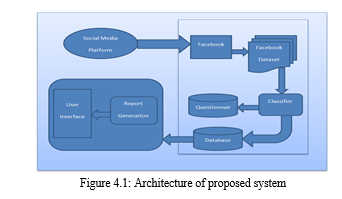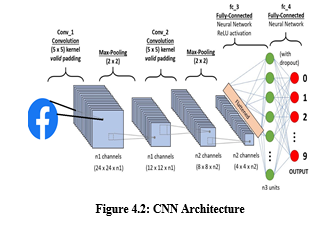Ijraset Journal For Research in Applied Science and Engineering Technology
- Home / Ijraset
- On This Page
- Abstract
- Introduction
- Conclusion
- References
- Copyright
Depression and Disclosure Behavior via Social Media using CNN and NLP
Authors: Mr. Suraj Damre, Yugandhar Desai, Vaishnavi Varkur, Anshika Tiwari, Aashvi Kothari, Gauri Bhand
DOI Link: https://doi.org/10.22214/ijraset.2024.62508
Certificate: View Certificate
Abstract
Nowadays, mental stress has become a danger to human progress. As life moves fast, more and more people feel uncomfortable. It is not always good to understand customer concern early and keep customers safe. Thanks to informal digital communication, people take the time to share some of their experiences and talk to friends through digital systems and media companies, making it possible to have online relationships that involve anxiety identity. In our paper, we found that in web-based omnimedia the user\'s stress state is related to the stress of his friends, and I use continuous data from appropriate levels to avoid always acknowledging the client\'s stress and relationship. Discussion In our system, we see that customer\'s kingdom anxiety is related to their friends\' digital kingship anxiety, and we use real advanced levels of important certification information to understand user stress and business relationships. together. As a shift in thinking, I started by unpacking many of the tensions around print, visual, and social, and proposed a format in which we could experiment with Facebook ads using the form of a neural network. We can understand if the customer is upset. After asking whether the patient is afraid or not, the assistant\'s opinion of the clinic should be checked, and the administrator can send a safe list to the user so that he can strengthen and shine in daily life. -CNN, classification, depression, machine learning;
Introduction
I. INTRODUCTION
We stay in a continuously converting social ecology, and our emotional moods are encouraged via way of means of a number of things. For example, we may be thrilled due to the fact there’s something for everyone, whether or not it is looking an excellent movie, consuming delectable food, or virtually having a terrific time. Because our pals are delighted, we can also additionally experience fulfilled handiest after finishing a tough task.
Automatic function extraction techniques (together with neural networks) have confirmed ability in detecting intellectual illnesses. These techniques use deep gaining knowledge of models' cap potential to robotically analyze applicable capabilities from unstructured textual content and images, in place of education on key phrases or sentiment dictionaries, which has clean blessings for growing techniques for growing precision public fitness interventions and treatments.

Public fitness agencies are worried approximately the effect of melancholy on society. According to the World Health Organization, melancholy influences 322 million humans worldwide, costing $2.five trillion (WHO). Depression is characterized via way of means of a gloomy, empty, or agitated attitude, in addition to physiological and cognitive impairments, which restriction an individual's cap potential to function in day by day responsibilities and social situations.

II. LITERATURE SURVEY
Fatemeh Mohades et al. Edward Lee et al. Over the years, the architecture of the Internet has remained incomplete. 1 Internet model chosen for its lack of interference. It has become cheaper, no longer requires the cooperation of many people or the almost impossible art of reviewing many batches of posts, and it avoids negative attitudes and criticism. Zepeng Li et al. 4521 people. To verify the effectiveness of the model, we conducted an experiment on the public Weibo database containing 7329 messages.
Zifan Jiang et al. [4] Participants of this study (n = 493) Prevention of cognitive impairment due to various motivational factors and many diseases in healthy adults.
Ashok Kumar et al. We basically divide sources and Celebrex data into 3 groups based on gender data: male, female and mixed. We use a combination of Bag of Words (BoW), Time Frequency-Inverse Document Frequency (TF-IDF), and International Word Representation Vectors (GloVe) to generate attributes for each entity. Then, to solve this problem, we apply the idea transfer problem and many methods to reprogram the neural network from the preferred ideas. and describe their struggles to help raise awareness. This stress is defined as an activity that requires attention. We're starting with resources for sharing Twitter messages that have no power in self-care. Various skills such as thinking, intelligence, behavioral skills, successful customer learning, and stress-related n-gram skills are extracted to create the product that each person uses. When using such features, we train a small-scale short-term (LSTM) network to predict depression using the Swish activation function. We conduct a large-scale test to demonstrate the effectiveness of our approach.
Fatemeh Mohades Deilami et al [7] Convolutional neural network (CNN) outperforms many deep neural networks and is used for some language processing, especially character search. We chose to combine CNN with AdaBoost (an integrated method) to see how we should use the results of different variables and ultimately maximize their performance by combining the distribution quality with the size of the care type skills using Ada Boost. The results show that our proposed method outperforms all other tools and provides a deep understanding of the content of the popular character in the dataset.
Sahraoui Dhelim et al. Second, we examined various disease prediction methods, including machine learning and deep learning. Finally, we discuss the context needed to identify aesthetic issues through social media use, including privacy and ethical issues, as well as the economic issues associated with the mass measurement and distribution of these systems over the years. Benjamin
Joseph Ricard et al. These studies have shown significant evidence that conversational data recorded with the help of a friend are often used to identify that person's depression.
AvikSarkar et al. [10] Each deep learning and machine learning method has its own specific applications and problems in order to overcome many problems. This study evaluates and compares the effectiveness of 4 deep learning methods based on neural networks (such as MLP, CNN, RNN, RNN with LSTM and supervised machine learning, SVM and LR) to detect beautiful melancholy using EEG personality and other mental illnesses. As mentioned in the relevant articles, we identified previous studies that are important for our picture. Then we tested the power of the classics we studied in-house. Data set. It has more than 20,000 healthy users and more than 10,000 depression patients, and all of them are classified and analyzed by experts. Ten statistical methods were collected and provided after examining the user's words, activities, and demographic characteristics.
M. Modern research by G. Shahnawaz et al. The component form of the Social Network Addiction Scale was determined by a more comprehensive evaluation of the first six subscales. We found that social interaction is an important part of testing, with a test-retest reliability of 88 over 25 days. The purpose of Study 3 was to determine the convergent and convergent validity of the Social Network Addiction Scale (SNAS). The convergent validity of the SNAS examines problematic Internet use, Facebook addiction, regular Internet use, and loneliness, while its divergent validity examines life satisfaction. Convergent validity and divergent validity of the SNAS.
III. PROBLEM STATEMENT
According to the World Health Organization (WHO), thousands of people worldwide suffer from depression. Despite advances in science and technology, many patients still seek poor quality care. Error analysis and correction. Mental illnesses are a burden that affects people's lives. Differences in thoughts, emotions, and life are a complex topic. The main effects on body health are primarily headaches, malnutrition and obesity. In addition to physical weakness, normal sleep may also be affected. Online advertising can be used because it contains a large amount of information that can affect the relationship between customers. Obtaining this information to assess the skill level of web-based media users can help professionals, their relatives or friends receive requests for information needed for research and treatment to combat those who fail.
IV. NEED OF THE WORK
In today's fast-paced and interconnected world, it has become important to think about health first. Just as physical health needs constant care and attention, mental health also needs care and proper management. Mental health assessment can play an important role in promoting healthy lifestyles by giving people the tools they need to understand, care for, and heal their hearts. Here are ten important reasons why maintaining mental health is important to maintaining a healthy lifestyle:
Knowledge and Attitude Personal: Mental Health Services encourage people to stop and reflect on their thoughts, feelings and behaviors. This increased awareness allows users to better understand their triggers, stressors, and patterns, thus increasing their intelligence. It can also be used for mental health problems. Regular use of the app allows users to notice changes in their mood and behavior, helping to detect potential problems early. Self-awareness for health. By analyzing tracking data, the app identifies patterns and relationships, helping users identify connections between their activity, sleep, and mood. Clutter. The Mental Health Tracker app helps users identify stressors and learn to manage them effectively through mindfulness, deep breathing techniques, and other stress reduction techniques. Sincerity is the key to happiness. These goals can range from getting enough sleep to practicing gratitude every day. The app allows users to set and track these goals, providing a sense of accomplishment and motivation. Mental health tracking apps help users establish a consistent sleep schedule, daily exercise and relaxation habits to maintain a balanced and healthy lifestyle. Causes and patterns that affect their emotional states. This information allows them to make informed decisions and take steps to improve. The app tracks sleep patterns and provides tips to improve sleep quality, such as maintaining a consistent bedtime and reducing screen time before bed. Resources like lectures, cognitive behavioral therapy, and health articles. These resources provide users with practical tools to manage their health. By using and discussing apps like these, people can help eliminate the stigma that comes with seeking mental health support.
V. PROPOSED SYSTEM

In online mental health support and intervention, using emotional intelligence to inform is useful for predicting and resolving mental health problems. Advanced machine learning algorithms can examine complex words and thoughts in user-generated content such as social media, forum discussions, or social networks to detect subtle patterns that indicate stress, anxiety, or depression. > Sentiment analysis algorithms carefully examine text data, carefully identifying and classifying words and sentences based on their emotional value (from positive to negative) and voice and speech nuances. This process allows these algorithms to classify text into different types of emotions, providing insight into the emotions of those engaged in digital media. For early diagnosis and intervention. For example, a sudden change in message from mostly neutral or positive to negative or stressful could be a red flag indicating the onset of stress. Similarly, the frequency and use of certain terms or phrases associated with depressive symptoms or suicidal ideation may provide insight into a person's mental illness. Demographics, employment history, or past interactions with mental health resources further increase the predictive power of risk assessment models. By taking into account a wide range of factors, these models can identify individuals at high risk of experiencing mental health problems, allowing for timely and targeted interventions. Platforms may use sentiment analysis to analyze incoming posts or messages. Automated systems can flag content that reveals emotional patterns for further analysis by experts or crisis responders to provide timely and appropriate assistance to those experiencing stress. Assist in the development of personalized intervention strategies based on the individual's needs and interests. By analyzing emotions and identifying stressors that arise or are associated with past crises, interventions can be identified to address underlying issues and improve protection. is key to progress in identifying and reducing mental health issues in the online community. These technologies have the potential to revolutionize mental health services by harnessing the power of speech and thought, providing timely and targeted support to those in need and promoting mental health management practices in the digital age.
A. CNN Algorithm
B By using repeated images, the convolutional neural network (CNN) can detect and understand the visual patterns used for the final purpose. ResNet is a version of CNN that, although not used in media, produces good results in image format. Automated feature extraction using CNN models has been proven to effectively read metrics from social media images. [4]
These algorithms differ from the guidance strategies for search shocks on Facebook and Instagram, which rely on constant inference by saturation and brightness wall. Average ranking or reducing complex images to simple features during the training version can also result in missing important information. Automatic feature extraction algorithms can learn how to find good images for the main purpose of green classification, which will be useful in social media research.

- Input image
The camera captures the image of interest and feeds it as input to Python for similar processing
2. Pre-processing
>Pre-processing of the image is often required to reduce the image. image frequency background noise normalizes the depth of the individual particle image, manages reflections, overlays the image. Image preprocessing is a method of enhancing recorded images before processing. When it comes to analyzing complex data, one of the biggest problems comes from many different variables. Here, the wavelet transform can capture the RMS value, mean value, entropy and other functions of the image. . Artificial intelligence is experiencing massive growth in bridging the gap between human and machine capabilities. Researchers and advocates are working to make a huge impact on many things in this field. Working on a computer is one of many jobs. The real-time domain is for machines to analyze the competition like humans, understand the same, and even use specialized information to complete various tasks, including information about image and video, image analysis and classification, media entertainment, recommendations, natural language processing, and more. , etc.
B. NLP Natural Language Processing
In the field of natural language processing (NLP), the goal is to enable computers to understand, interpret and produce human language in a way that reflects the same human understanding. Just as convolutional neural networks (CNN) are good at visualizing patterns in images, NLP models are designed to extract visual content and patterns from textual data. It is a model like BERT (Bidirectional Encoder Represented by Transformers). Although these models are new to the field, they have been quite successful in many languages. Structure and relationship between sentences. This process usually begins with tokenization, where the sentence is broken down into words or subwords, and techniques such as stemming or lemmatization are used to reduce words to their basic forms.

Next is the embedding phase, where words are mapped to high-dimensional vectors to capture semantic similarities between them. This step is important for the model to understand the meaning of the words in the sentence. Change it to a lowercase number and press and hold the abbreviation or abbreviation.
Once the text is processed and features are extracted, the NLP model, like the CNN model, starts performing classification or other tasks. This may include proofreading, name recognition, drafting, machine translation or other language-related tasks. Just as CNNs help computers interpret and classify visual data, enable computers to not only understand text but also generate contextually appropriate responses and predictions..
Ultimately, the goal of NLP models is to bridge the gap between human language understanding and machine comprehension, enabling computers to not only understand text but also generate contextually appropriate responses and insights, much like how CNNs enable computers to interpret and classify visual data.
VI. FUTURE WORK
Going forward, our project aims to make our stress tests smarter and more attuned to the nuances of human experience. We are happy to share in depth how our relationships affect our brain. Imagine being able to understand not only what's going on within ourselves, but also how our interactions with others affect our stress levels. Think of this as adding more layers to our understanding of the stress-causing complexities of our lives. We want our machines to be able to analyze not only what we say or do, but also how we interact with others on social media or in our daily conversations. It's data and algorithms. We are still working on making our bodies more personal. We hope it becomes clear that everyone responds to stress differently and there is no one-size-fits-all solution. This means customizing our technology for each user and situation. Your people are here to support you and help you through life's ups and downs. By combining technology with the human touch, we hope to make a real difference in people's lives.
Conclusion
In summary, our research examines the integration of advanced techniques such as multi-label search, CNN algorithms, bidirectional and multi-channel bidirectional recurrent neural networks, and evaluation control representation. Using patterns, labels, and metrics, we evaluate the model\'s performance in predicting individual activities based on social and smartphone behaviors. The Essentials: An Essential Tool for Health-Seeking Individuals. These practices support self-awareness, early detection, self-understanding, stress management, goal setting, daily growth, reaching heights, developmental sleep, access to resources, and reducing pollution. Using these apps in daily life can improve mood, improve self-care, and ultimately improve quality of life. The ability to increase the efficiency of services. Leveraging natural language processing, these apps can improve users\' mental health experiences by providing personalized support and interventions tailored to the individual\'s needs. This comprehensive approach has the potential to revolutionize mental health care and improve outcomes for people around the world.
References
[1] Fatemeh Mohades Deilami1, Hossein Sadr2, Mozhdeh Nazari3.” Using Machine Learning-Based Models for Personality Recognition” IEEE 2022. [2] Edward Lee and Andrew Moshirnia.” How Education Level and Social Media Use Increase Belief in Misinformation” IEEE 2022. [3] Li, Z.; Zhou, J.; An, Z.; Cheng, W.; Hu, B. Deep Hierarchical Ensemble Model for Suicide Detection on Imbalanced Social Media Data. Entropy 2022, [4] Zifan JiangID, Salman Seyedi1, Rafi U. Haque3, Alvince L. Pongos3, Kayci L. Vickers3, Cecelia M. ManzanaresID 3, James J. Lah3, Allan I. Levey3, Gari D. Clifford.” Automated analysis of facial emotions in subjects with cognitive impairment”2021. [5] Ashok Kumar Ja, Tina Esther Truemana, Erik Cambria.” Gender-Based Multi-Aspect Sentiment Detection using Multilabel Learning”2022 [6] Shreya Ghosh, Graduate Student Member, IEEE, and Tarique Anwar.” Depression Intensity Estimation via Social Media: A Deep Learning Approach” IEEE TRANSACTIONS ON COMPUTATIONAL SOCIAL SYSTEMS 2021. [7] Fatemeh Mohades Deilami1, Hossein Sadr2, Mozhdeh Nazari3.\" Using Machine Learning Based Models for Personality Recognition\" 2021 [8] Sahraoui Dhelim1, Liming Luke Chen2, Huansheng Ning1, Sajal K Das3, Chris Nugent2, Devin Burns4, Gerard Leavey5, Dirk Pesch6 and Eleanor Bantry-White.” Social Behavior and Mental Health: A Snapshot Survey under COVID-19 Pandemic” 2021. [9] Benjamin Joseph Ricard. “Machine learning method in social medi analysis with applications in mental health\" 2021. [10] Avik Sarkar, Ankita Singh b, Rakhi Chakraborty.” A deep learning-based comparative study to track mental depression from EEG data” 8 September 2021 [11] Pratyaksh Jain. “Depression and Suicide Analysis Using Machine Learning and NLP” 2022. [12] Zhenyi Wang, Chenghao Li, Yilin Zhang.” A MULTITASK DEEP LEARNING APPROACH FOR USER DEPRESSION DETECTION ON SINA WEIBO”26 Aug 2020 [13] M. G. Shahnawaz & Usama Rehman.” Social networking addiction scale” 2020. [14] Nur Hafieza Ismail, Mengnan Du, and Xia Hu.” Social Media and Psychological Disorder” 2020. [15] Florian Arendt , Sebastian Scherr, Daniel Romer.” Effects of exposure to self-harm on social media: Evidence from a two-wave panel study among young adults”2020
Copyright
Copyright © 2024 Mr. Suraj Damre, Yugandhar Desai, Vaishnavi Varkur, Anshika Tiwari, Aashvi Kothari, Gauri Bhand. This is an open access article distributed under the Creative Commons Attribution License, which permits unrestricted use, distribution, and reproduction in any medium, provided the original work is properly cited.

Download Paper
Paper Id : IJRASET62508
Publish Date : 2024-05-22
ISSN : 2321-9653
Publisher Name : IJRASET
DOI Link : Click Here
 Submit Paper Online
Submit Paper Online

